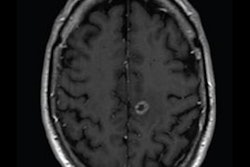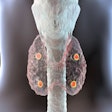
Chest CT isn't usually associated with breast cancer detection, but maybe it should be: The modality can identify incidental, suspicious breast lesions in women undergoing the exam for other reasons, and many of these lesions are malignant, according to a study published on 14 June in Breast.
The study findings suggest that radiologists should keep breast cancer in mind when interpreting chest CT scans acquired in women for other indications, wrote a team of German researchers led by Dr. Martina Georgieva of the University Hospital Regensburg.
"Breast lesions can be incidental findings on chest CT," the group noted. "Even though chest CT cannot provide all information necessary for classifying breast lesions, it seems to be helpful for evaluation of tumor suspicious changes in dense breast tissue. This may ultimately influence patient management and lead to further imaging. Therefore, a thorough examination of the breast, even on routine chest CT for other indications, is crucial."
When it comes to breast imaging, CT isn't the first modality to come to mind. Mammography is the gold standard for breast cancer screening, with ultrasound and breast MRI also used depending on tissue density and/or a woman's risk factors for the disease.
Part of why CT isn't thought of as a breast imaging tool is due to the radiation it imparts -- a thoracic CT exam's effective dose is between 4 mSv and 7 mSv, much higher than that of mammography, which ranges from 0.2 mSv to 0.3 mSv, the researchers noted.
But as CT technology's spatial and temporal resolution has improved, its efficacy for identifying breast lesions has increased, according to the authors. Georgieva and colleagues sought to investigate the performance of chest CT for identifying incidental breast lesions via a study that included 35,000 chest CT exams performed between January 2016 and December 2020. The CT exams were conducted for such indications as suspected severe pneumonia, follow-up after melanoma or T-cell lymphoma, thoracic pain due to spinal metastasis.
Out of these, 31 incidental breast lesions were identified in 27 women. The lesions had a mean size of 2 cm; 22.2% of them contained calcifications. Two radiologist readers scored these lesions morphologically, then compared the CT findings to histopathology gained via ultrasound-guided needle biopsy or surgical excision.
Of the 31 incidental breast lesions, 23 were cancerous (74.2%) and eight were benign. Of the malignant lesions, 17 were carcinomas and six were metastases (four lymphomas and two melanomas). Of the benign lesions, two were hematomas, four were fat necrosis, and two were fibrosis lumps.
It's not that women should be routinely referred to CT for breast imaging, but radiologists would do well to keep a patient's breast health in mind when reading CT exams taken for other reasons, according to Georgieva and colleagues.
"[It] is important for radiologists to examine the breast tissue more thoroughly on routine chest CT examinations and characterize incidental lesions as either clearly benign, indeterminate, or suspicious with necessity for biopsy," they wrote.



















